Executive in Action: James Tham
This year, crew boat designer, builder and operator Penguin International of Singapore reached the milestone of owning more crew boats than ferries. Having divested all other vessel types before that, and being the most prolific builder of aluminium crew boats in the market, it is tempting to think the company is moving towards specializing in crew boats alone.
 Despite the challenges in the ferry market, this is not the case, says group managing director, James Tham. The company’s most recent deliveries include three 238-pax monohull ferries to Singapore’s Horizon Ferries co-designed between Penguin and BMT Nigel Gee.
Despite the challenges in the ferry market, this is not the case, says group managing director, James Tham. The company’s most recent deliveries include three 238-pax monohull ferries to Singapore’s Horizon Ferries co-designed between Penguin and BMT Nigel Gee.
“In Southeast Asia these days, there are very few passenger ferry routes that are truly profitable or sustainable,” says Tham. “The Singapore-Batam route, for example, is beset by cut-throat competition, which has driven ticket prices down to their historical lows. Competition notwithstanding, the reason why Horizon Ferries is ordering new ferries from us is because - unlike the other ferry operators - they have access rights to a popular ferry terminal in Batam that is privately owned.”
With few exceptions, crew boats offer better returns than passenger ferries, although softening oil prices can change market sentiments rapidly. “In Penguin’s case, we have yet to see a drop in crew boat demand as we are still taking orders right up to the end of 2015. But we are not immune to negative oil price sentiments.
 “Being a designer, builder, repairer, owner and operator of crew boats, with yards in Singapore and Indonesia, does give us a distinct competitive edge over a pure crew boat builder or a pure crew boat operator,” says Tham. “If prices plunge to 1999 levels, the surviving crew boats will be those that are newer, simpler and most economic to own and operate. The over-engineered crew boats and fast support intervention vessels (FSIV) will be the first casualties of an oil crisis.”
“Being a designer, builder, repairer, owner and operator of crew boats, with yards in Singapore and Indonesia, does give us a distinct competitive edge over a pure crew boat builder or a pure crew boat operator,” says Tham. “If prices plunge to 1999 levels, the surviving crew boats will be those that are newer, simpler and most economic to own and operate. The over-engineered crew boats and fast support intervention vessels (FSIV) will be the first casualties of an oil crisis.”
Penguin has a build cycle of less than six months for its flagship Flex-40 Series of crew boats, which is an upgraded and enhanced version of the Flex-38 Series and features upsized fuel and passenger capacities, improved seating, re-engineered propulsion and a Palfinger knuckle-boom deck crane as standard equipment.
“Looking ahead, we will continue to press on with our proven “Flex Your Fleet” strategy by enhancing and expanding our product line-up, increasing our shipbuilding capacities in Singapore and Batam, and adding to our own Flex fleet for charters in Southeast Asia. Without a doubt, we need to keep innovating and upgrading to stay ahead in the crew boat business, or any business for that matter.
.jpg) “Our research and development addresses common issues faced by all crew boat and FSIV owners: The need for speed versus fuel efficiency; improved comfort and amenities for passengers and crew; as well as bigger and more sophisticated vessels to support deep water, remote offshore operations. The kind of innovation we are looking at includes (i) redesigning hullforms and propulsion systems (ii) ride control systems and (iii) hybrid engines, just to name a few.”
“Our research and development addresses common issues faced by all crew boat and FSIV owners: The need for speed versus fuel efficiency; improved comfort and amenities for passengers and crew; as well as bigger and more sophisticated vessels to support deep water, remote offshore operations. The kind of innovation we are looking at includes (i) redesigning hullforms and propulsion systems (ii) ride control systems and (iii) hybrid engines, just to name a few.”
Tham believes that more and more FSIV will be fitted with dynamic positioning (DP) in the future, particularly those that are 50m or longer. “For midsized crew boats sized between 35m and 45m in length, DP is really not a necessity. For smaller crew boats, even a bow thruster is redundant. Remember, crew boats are by nature light and highly maneuverable. Because crew boats are not expensive to own, it’s so easy to over-engineer one and forget about weight, space and crew competency.”
Penguin continues to benefit from the integrated shipbuilder-operator model which Tham believes has inherent strength, in good times and bad. “The challenge is in building up and managing the integrated model such that you are constantly leveraging on its strengths. Many people fail in this aspect because of corporate infighting and overexpansion. At the end of the day, you need to rein in that hubris.”
In the coming year, Penguin will continue its relentless drive in research and development, as well as upgrades and enhancements, amidst a blistering pace of demand-driven production and fleet expansion, but Tham is a conservative man by nature. “We may take on debt selectively, but we will not fund our build-for-stock program with borrowings. We may appear aggressive in our building program, but we will only build to meet demand. As we grow our fleet, we will also keep a close eye on day rates and utilization.”
The opinions expressed herein are the author's and not necessarily those of The Maritime Executive.
